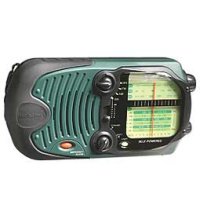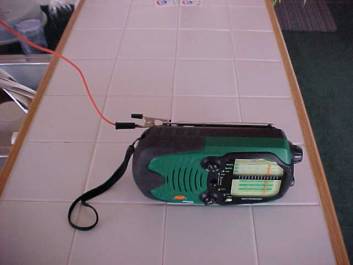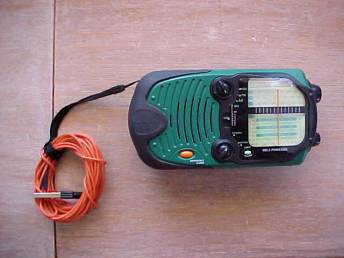By: Radio Ray
3/28/02
The Radio Shack Multi-band Self-Powered Radio
Model Number 12-803

The Radio Shack Multi-band Self-Powered Radio
Model Number 12-803

While surfing the net at some of my usual haunts, the topic of a Bug-out-Bag and it's contents came up. Those of us who have been in the "survival" mind set for a while know that this is a HOT topic and one that is often the center of great debate.
One of the items which I have found to be VERY important when 'hunkering down' either during severe weather, man made disasters, the local military coup de jour as when I was on the Thai/Cambodian border, is some way of gathering INFORMATION. I believe that the BEST way to do this is by having a radio capable of receiving local broadcasts, which in much of the world means AM & FM radio. I also insist on being able to receive news & information from International sources so that I can listen to many divergent views on events and formulate my idea of what is really happening. This requires short-wave radio.
Americans don't know very much about short-wave radio. Unlike the AM & FM radios stations which we are used to, short-wave signals “bounce” all over the world, so it’s possible to receive stations from the other side of the globe, often as clearly as if the radio station were in the neighboring town.
In much of the world, since the 1930's short-wave radio was the only way to learn what was going on outside of your local news & disinformation stations. During World War II and all through the Cold War, broadcasts leapt across international borders in virtually ALL languages, bringing a different perspective on world events than would be allowed in occupied nations. The information flow went both ways too! As a boy I used to listen during the 1960's to Radio Moscow (now the Voice of Russia), The Voice of Viet Nam from the communist north, Radio Havana Cuba, and the list goes on. The many foreign stations that I listen to and the growth of domestic U.S. “patriot” broadcasters have always kept me better informed than most of my countrymen. I generally have a very poor view of the US media and it's idea of what's news.
Some examples of what I mean by being informed? Well, I've already mentioned hearing about one of the many coups in Cambodia while I was working along their border in Thailand. There was an oil tanker which split it's hull in Huntington Beach when I lived on the beach. The BBC reported the oil spill in less than 45 minutes after the event while my local news waited until the 11 o'clock news to mention it. I'm glad that it was an oil spill and not a cloud of poison gas! I knew when the U.S. was going in to Desert Storm by monitoring the long range communications from military pilots who were making “phone-patches” to their family members, telling them that they were not coming home on schedule because the government had placed them on active duty and they were flying to the middle east.... Bad communications security on their part.
With the recent attacks on America and the likelihood of more to follow, it's good to keep informed on an international point of view, both for the need for more eyes & ears reporting the situation and to know what all side are saying. Is Germany REALLY saying what CNN says that they are? How about Saudi Arabia, Japan or Russia? You can learn this for yourselves by tuning in their short-wave broadcasts to America. Most of the nations also have language courses on the radio! Wouldn’t you love to tell your friends “Da, ja izuchaju Ruski pa radiu!” Yes, I’m studying Russian by radio...” ;^)
As survivors, you know that it's essential that your flow of information
not stop if the “lights go out”.
During an emergency is when you need reliable information the most!
Speaking of lights going out,
remember when this happened in California and a few other western states,
the massive power grid
damage in Canada and the northeast in the aftermath of powerful storms.
Don't forget that we STILL have the energy shortage due to decades of government
mismanagement which promoted the
decommissioning of power stations, prohibition of nuclear power plants,
while encouraging immigration into the states in the multiple millions
without providing the basics of power & water required. Hmmm
- should I mention here that you should always provide for you own welfare
& safety and never depend upon the government?
So, if there is no electrical power, or you are out in the boonies but your priorities don't allow you to squander vast amounts of your hard-earned money on radios, then you are in luck! Radio Shack - the 7-11 of things electronic, has introduced a new radio which fits the bill for daily as well as emergency usage. This radio is small (4”x8”x3”) and light, tunes AM & FM, short-wave and NOAA weather radio. This radio can run on two "AA" batteries. It's entirely self contained; no need to plug it in to the wall and should you not want to use your precious “AA” batteries, you merely switch it to hand crank - called "dynamo" - and crank for a little less than two minutes. This is the BEST OF ALL, because this radio has a small folding hand-crank on the back panel that runs a generator inside of the radio which recharges a set of internal NiCad batteries (provided with the set). Turning the crank for 90 seconds charges the NiCad batteries enough to listen for approximately 30 minutes! If you turn the crank longer, then you can listen for longer, the radio will play while you turn the crank, so there is NO interruption in listening. How does this little radio perform? I compared the hand-crank radio with my Grundig 800; a TOP of the line short-wave radio and also with the mobile Ham radio in my 4x4. Here's what I found:
Performance
Upon walking out the front door of my local Radio Shack, I began removing
the radio from the
packaging. By the time that I reached my vehicle I opened the
battery box on the rear panel of the radio, plugged in the NiCad, rechargeable
internal battery pack as per the instructions, folded out the crank handle
from it's nook on the rear panel of the radio and cranked for 90 seconds,
extended the whip antenna and tuned to the 16 meter band short-wave while
the radio was on the hood of my 4x4. This is a good band for listening
during the middle of the day. Short-wave is generally better from
dusk to dawn. This being the middle of the day, I wasn't expecting to hear
much - if anything. I was in for a surprise! Within five minutes
I had tuned in China, Canada, Voice of America, Germany, Holland.... you
get the picture. Yes, I have better filtering on my high dollar
radios, so the fading and static would be less noticeable, BUT the
same stations on the Radio Shack radio were very understandable and most
were loud & clear. The weakest stations were more easily received
using a wire attached to the little radios’ whip, but this was not
absolutely necessary. Comparison: gooood! especially
when you realize that you can buy two dozen of the Radio Shack radios for
the price of what I have in my vehicle! There’s safety in redundancy,
so buy two: pack one and enjoy the other.
Switching to the "weather" band on the radio, I quickly found my local NOAA (National Oceanographic & Atmospheric Administration) weather forecast coming in loud & clear! This is a service which not only gives you 24 hour weather forecasts but also emergency information and severe weather warnings. I rely on them often.
Once I returned home I attached a few yards of scrap wire to the radio's
whip antenna to boost the
signals a little bit and began twisting the knob to see what I could
hear. Very soon I had all the above countries and several more bringing
me news, information and entertainment - free. The wire I used
was just a few turns of the bare end of speaker wire wrapped around the
radio's whip antenna and the rest draped across the curtain rods for about
10 feet. An alligator clip on the wire would make it even more convenient.
I love the Internet, but with short-wave radio I can get my news even if
the net dies from congestion as my local area did for about a day
and a half after the World Trade Center & Pentagon were attacked.
Remember , cyber-attacks are one of the scenarios which we are told to
be on the alert for. Be prepared. Get this radio!
Physical Attributes
Physically the radio is a handy size, measuring just over (4”x8”x3”) it's obviously built to be rugged. The radio and all knobs are well rounded and should not get snagged on gear while being shoved into and pulled out of a ruck sack or cut the fabric on your pack and clothing. The hand-crank folds neatly into the rear of the radio. Take it from someone who has carried more radio gear on his back than most people you'll ever meet: this IS important! I've seen the sharp edges of radios cut through ALICE packs, clothing and even open up flesh. I like rounded and curvy!
The designers also provided two jacks on the radio. One is a standard earphone jack which works with the commonly available "WalkMan" type headphones. Sound quality is actually quite GOOD when using headphones/ear-buds. I would HIGHLY recommend that you have earphones available with this radio, especially when you are in the wilderness. There are few things more irritating than the sounds of civilization while in the woods. Use earphones when you're in your shelter at night. It’s also good operational security to not announce your presence if you are evading. Use phones when you are the only one listening and save the speaker for when you have a group listening.
Antenna Ideas

Attaching a length (5 or more feet) of multi-strand wire to the radios’
whip antenna increases
performance on short-wave and allows you to listen to very weak stations
which you might not be able to hear using only the built-in whip antenna.
I put an alligator clip on the end of my antenna wire so that I can attach
it without even extending the whip antenna at all. The wire is not
any special type: any scrap wire will do. In a pinch you could use
speaker wire, telephone hook-up wire, barbed wire. I’ve even used extension
cords strung around the house and yard and used a short ‘pig-tail’ of wire
to connect the cord to the radio’s antenna. When you use the radio
indoors, you can string the antenna wire out the window to a nearby tree
etc. The general rule with antennas is: “The Higher, The Better.”

When not in use, I coil the antenna wire and loop the radio’s wrist
lanyard through the
coil of wire to keep it stored with the radio.
The second jack is for providing external power to the radio (3 vdc). This might be from a "wall wart" plug-in power supply, an external battery or solar panel. This is a good feature for me, because a solar panel is a standard part of my emergency kits. Yes, I have more than one kit.
Considering all the careful research and design that obviously went into producing this radio, there is one feature which is amusing, bordering on comical: that is the "EMERGENCY ALARM". This is activated by a small, orange button on the front panel of the radio. Approximately 5 seconds after pushing this button a loud, high pitched 'chirping' begins to come from the speaker. Hmmm, the manual says about this feature:
"Emergency Alarm - lets you use the radio to sound a shrill, repeating beep when you are in distress."
I don't know. This is the only "cheesy" thing on this entire radio. It seems to me that if I WERE in distress that nobody would be able to hear this 'chirping' over the sound of my screaming, yelling and shooting, but that's just my opinion. There is a small button which turns on a panel light so that you can read the dial in the dark. This is a good feature.
Specifications
AM 530 - 1710KHz
FM 88 - 108 MHz
Wx 162.40 - 162.55 (NOAA weather band)
SW1 5.81 - 6.20MHz
SW2 7.10 - 7.60MHz
SW3 9.45 - 9.90 MHz (Mine gets WWV time station at 10.0 MHz
SW4 11.55 - 12.15MHz ( Mine gets 12160 & 12172 “Patriot” radio.)
SW5 15.10 - 15.70MHz
SW6 17.45 - 18.15MHz
Size: 4”x8”x3”Weight: 1 lb 4 oz.
Price: $59.95 USD
Modes:
AM & FM broadcasts
Weather radio in the FM mode.
Short-wave in the AM mode for international broadcasts.
In Closing
Many short-wave radios are designed for ‘techies’, that is, they are a bit complicated for the first time user. The Radio Shack hand-crank radio is not one of those types of radios. It is as simple to operate as your kitchen radio. You turn it on, turn the knob until you hear something that you want to listen to. That’s it.
Do yourself a favor. Go to your nearest Radio Shack and BUY THIS
RADIO (Item Number 12-803). Take it home, have fun with it and pin a note
to your Bug-Out-Bag reminding you to take this radio with you in case of
emergency. If you have the spare cash, buy two, play with them both
then pre-pack one.
RadioRay ..._._
Wilderness
Survival Trips With RadioRay

All materials at this site not otherwise credited are Copyright © 1996-2002 Trip Williams. All rights reserved. May be reproduced for personal use only. Use of any material contained herein is subject to stated terms or written permission.